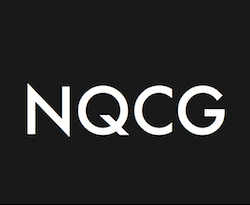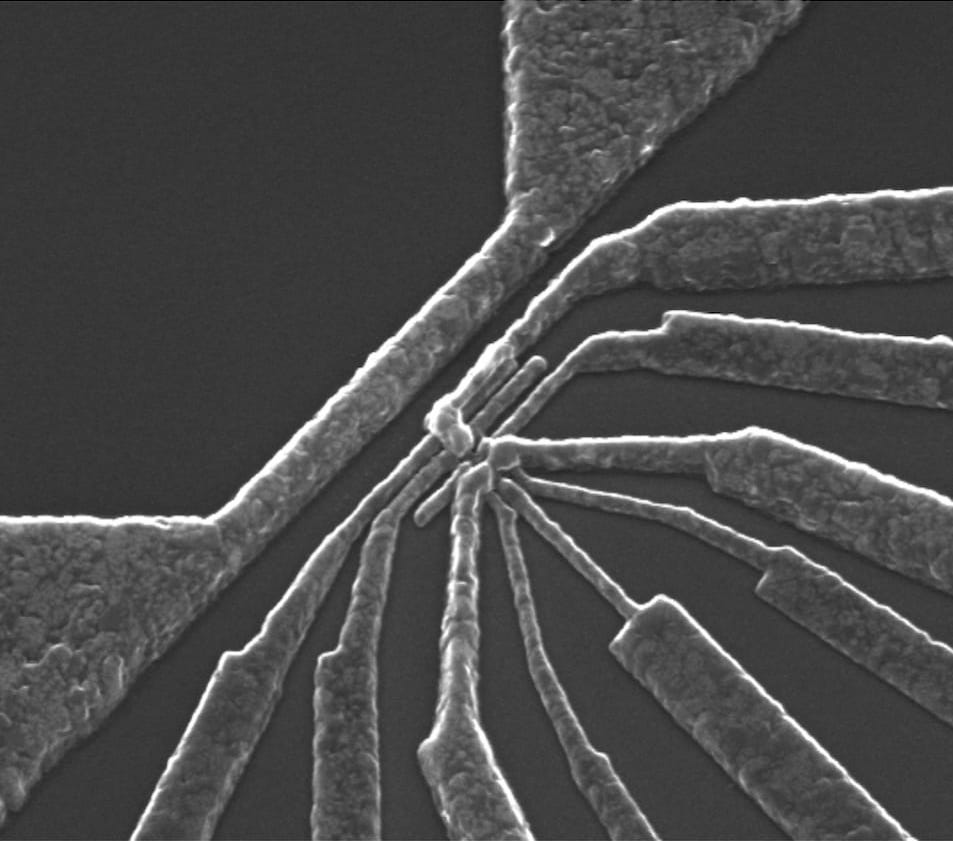Quantum Information Science and Technology
NQCG’s primary research interest is the realization of analogue quantum simulators – computational tools that enable complex simulations of physical systems in the fields of nanoscience and continuum mechanics. While apparently different on the surface, these two application fields share the common trait that their central problems are best formulated as analogue computational problems.
Analogue quantum simulators, which were Feynman’s initial notion of quantum computers, have proven easier to scale up than any system of quantum bits (“qubits”) designed for digital operation. After a comprehensive survey of the progress in quantum computing by NQCG, laser manipulation of trapped ions appears to be the most scalable approach to both large-scale analogue quantum simulators, as well as to producing practical digital quantum computers.
Large Scale Quantum Simulators for Nanoscience and Continuum Mechanics
The theoretical computing power of N qubits scales as 2N, instead of the 2N scaling achieved with classical bits. For exactly the same reason, classical computers quickly become inadequate on the scales needed to simulate the collective quantum phenomena that make up much of the novelty of the nanotech field. This fact may imply an unwelcome predicament for the foreseeable future of the field of computational nanoscience. It also implies that the feasibility of the many proposed designs of quantum computers cannot be adequately evaluated without actually trying to build them.
From a survey of quantum computer research and development and from our perspectives of state-of-the-art nanotechnology, NQCG believes a practical gate-model (digital) quantum computer for large scale problem solving may not be realized in many years, if ever. Thus, we propose building large scale analogue quantum simulators (AQS) and to develop an analogue computing theory to suit a wider range of applications. The analogue quantum computer is by no means a new idea; however, its feasibility and applicability has not received nearly the level of attention, as the digital quantum computer. A strong argument for exploring AQS is that physical behaviours in Nature resemble analogue, rather than digital, processes, which means that many of the problems connected with binary representation and qubits can be circumvented. For this reason, NQCG believes it is worthwhile to explore ways to overcome the limitations of the classical analogue computer - namely accuracy and range of values - at the quantum level.
To this end, we intend to develop large scale AQS in parallel with new analogue theory to enable simulation of key physical processes in proposed qubit systems to judge the feasibility of proposed models of digital quantum computers. Even if the AQS paradigm does not reach this level of sophistication, a working model will still have a wide range of applications in computational nanoscience and in the modelling of continuous processes. A large portion of the CPU hours delivered by today’s supercomputers is expended on weather forecasting and design problems in the aeronautics industry. With large scale AQS we foresee, for example, the possibility to out-compute the problem of turbulent flow around an airfoil without resorting to the standard approximations of the Navier-Stokes equations.
Our strategy for our quantum computing research program is based on the following:
- Thousands of person-years of labor have been invested in the problems associated with gate-model quantum computing (e.g. upscaling, decoherence).
- Today there are about 20 different suggestions for physical systems to be used as qubits in the gate-model QC approach, none of which today stands out as more promising than the other.
- For simulation of quantum processes, digitisation has no advantage over analogue computing.
- Development of analogue quantum computing (e.g. adiabatic, quantum annealing, etc.) and development of analogue computing theory in general both lag that of gate-model QC.
- AQS is also believed to be much easier to realise than the gate-model (compare the effort that has already been done in gate-model QC).
We therefore build an Analogue Quantum Computer (AQC) for simulating quantum mechanical processes, in parallel with development of the appropriate analogue computational theory. Eventually, AQCs will be able to simulate the operations of the many proposed models for gate-model QC, and thus will be able to determine which (if any) of these can be realized practically. Should our development of AQC not reach this level, the effort will still have a great impact in nanotechnology, chemistry, and reaction physics.
Note: A general purpose computer is probably digital; it is proved that a digital computer can do everything an analogue computer can, but the inverse assertion is unproven. For certain specialised tasks (such as quantum simulations), analogue computers can be faster than digital.
Scientific background
The development of analogue computers and analogue computing theory was more or less terminated when digital computers gained complete dominance long ago. The digital computer is more versatile and accurate, but the fact remains that for certain tasks, like simulation of continuous processes and solution of differential equations, the speed of the analogue computations cannot be approached by digital machines. Until recently, the digital (i.e. gate-model) quantum computers attracted nearly all the attention, despite the fact that Feynman’s vision of the quantum computer1 was inspired by the idea that the behaviour of one quantum system can be simulated by another. The correctness of this idea has later been proved by Lloyd2.
The great interest in the digital quantum computer is due to the computing power of N qbits, which scales as 2N, instead of the 2N scaling achieved with classical bits. For N≈50, the most powerful digital computers of today will be outperformed. The great problem facing complex logic quantum operations is that the qubits must be allowed to interact with each other, but not with the environment. Since this ideal situation is impossible, quantum error correction codes have been designed to mitigate the leakage of information; however, it turns out to be very difficult, if possible at all, to scale up from small demonstrations involving a few operations on a few qubits to large systems employing the necessary level of error correction.
Many natural processes resemble analogue rather than digital computations and analogue quantum simulators of the kind Feynman proposed have recently started to regain attention. Analogue quantum simulators do not rely on operation of qubits and thus avoids the problems connected with coherence and entanglement in digital quantum information processing. This suggests that upscaling is easier to achieve with analogue than digital quantum processors and promising results have been achieved for various analogue designs3,4.
Objectives
The goal of NQCG is to realize practical quantum simulators for applications in nanoscience and continuum mechanics. Since analogue quantum simulators appear more feasible than gate-model quantum computers, the primary objective is to develop an AQS platform capable of solving complex many-particle and continuum mechanics problems. This approach is also likely to yield results of importance also for digital quantum information processing.
Contrary to digital computers, the physical designs of analogue computers are intimately connected to the processes they are intended to model. The range of problems a particular analogue computer can solve thus depends on the state-of-art of the analogue computing theory, a research field which was largely abandoned together with the classical analogue computer. The secondary objective of this project is therefore development of analogue computing theory to achieve simplified design and efficient use of analogue quantum simulators.
Scope
Although fulfilment of these objectives allows a wide range of scientific and engineering problems to be addressed, the scope of this work is limited to applications in nanoscience and continuum mechanics. The reason is that both fields offer problems which are currently computationally expensive or intractable, but well suited for analogue computations.
Approach
A comprehensive survey of past and recent developments in the field of quantum computing has convinced NQCG that laser manipulation of trapped ions is the most promising road to both analogue and digital quantum processing on the scales required for practical computations. Stimulated Raman transitions in a single trapped ion can be used to simulate a wide class of fermion states in an arbitrary external potential3 and NIST researchers have recently achieved the most significant breakthroughs in digital quantum information processing by using trapped ions as qubits.
NQCG will develop the experimental techniques of trapped ions and concomitant laser manipulation to the level needed for large-scale analogue quantum simulation. In parallel, NQCG will develop analogue computing theory and research simulator designs for specific classes of problems in nanoscience and continuum mechanics. Limitations in experimental ability may be mitigated by simplified simulator designs and advancements in analogue theory.
Quantum Computing together with other high potential implementations
Simulation has always been an important part of what conventional computers do. For engineers and scientists, simulation is about asking “what if” questions without having to actually do it. Today’s engineering marvels would not be possible were it not for computer modeling. Everything from the car you drive, to the plane you last flew in, to the building in which you sit, to the computer chip in your PC, are made possible by simulation.
There is an implicit assumption that the tactics used in engineering today will apply to engineering at the nanoscale. The promise of nanotechnology is based on the premise that since everything is built of atoms, if we can manipulate matter on the level of atoms, we can build anything that is physically possible.
Building, however, is only a part of engineering. Just being able to build any given assembly of atoms does not mean that we can predict how it behaves before we build it.
Unfortunately, conventional (non-quantum) computers, no matter how powerful, are very bad at predicting the behavior of nature at the nanoscale. The quantum properties of matter and energy that make nanotechnology so interesting wreak havoc with conventional simulation methods.
Quantum Computers are the only known solution to this problem. They are able to directly solve the fundamental equations of quantum mechanics for any physical system. Sufficiently robust Quantum Computers will be able to create the ultimate virtual reality environment, where products and processes at the level of atoms and molecules can be exactly and effortlessly probed.

 Image Courtesy A. Dzurak, University of New South Wales
Image Courtesy A. Dzurak, University of New South Wales